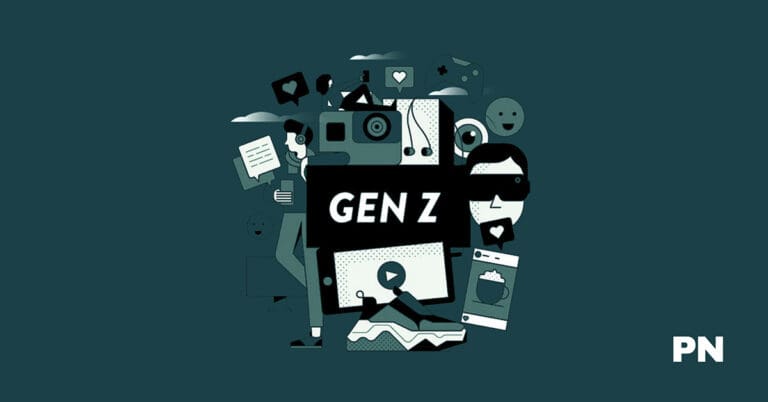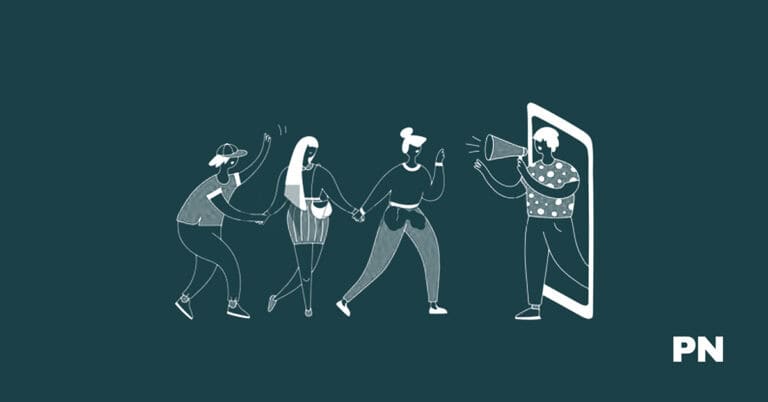50 Incredible Word-of-Mouth Marketing Statistics

Word-of-mouth marketing is as old as marketing itself. Brands create awareness about their business by getting others to talk about them.
Having been around for centuries, how does this marketing strategy appeal to today’s audience?
Studies reveal that brands benefit substantially from positive customer experiences, with 72% of consumers eager to share satisfactory encounters.
This sharing drives a significant spike in sales, outperforming paid advertisements by a factor of five.
Moreover, the trust instilled by personal recommendations is unparalleled; a staggering 88% of people trust brands endorsed by their friends or family.
1. Word-of-mouth is directly responsible for 90% of all purchases.
Word of mouth is so powerful that it drives $6 trillion in annual global spending and is responsible for 13% of all sales.
People are most likely to trust reviews or recommendations from other people.
2. 32% of people come across new podcasts from word-of-mouth recommendations and 29% specifically from friends’ recommendations.
(Source: SemRush)
When discovering new podcasts, a significant number of listeners rely on recommendations from others.
Word-of-mouth recommendations could stem from various sources:
Conversations with friends or family: People tend to trust the opinions of those within their social networks.
Discussions with colleagues or acquaintances: Casual conversations at work or social events can lead to new podcast discoveries.
Online communities and forums: Interest groups often share podcast suggestions.
Social media interactions: Recommendations may come indirectly through posts, shares, or comments from personal connections.
3. Compared to other types of advertising, word-of-mouth marketing is 37% better for retaining customers.
(Source: Deloitte)
Effective customer retention is a cornerstone for long-term business success. Word-of-mouth marketing outperforms other advertising forms when it comes to keeping customers engaged and loyal.
Customers have a natural inclination to trust the opinions of friends and family over other forms of advertising.
Also, personal experiences shared by existing customers carry more weight and authenticity. The more customers trust you, the more they keep returning.
4. 72% of consumers will talk about a good experience.
(Source: Esteban Kolsky)
The power of positive customer experience is immense in driving word-of-mouth (WOM) marketing.
Consumers often discuss their positive encounters during personal interactions, which can influence the purchasing decisions of others in their social circle.
For example, many satisfied customers turn to online platforms to express their contentment with a service or product.
Positive experiences can go viral on social media platforms, amplifying the reach exponentially beyond the immediate network.
5. Influencer Marketing Carries a Return on Investment (ROI) of $6.50 for Every Dollar Spent.
(Source: Neil Patel)
Influencer marketing has established itself as a powerful channel in the advertising industry.
Selecting the right influencers who align with the brand’s values and target audience is critical for maximizing ROI.
Companies should approach influencer marketing strategically and be aware of the potential for high returns.
6. Millennials were 38% more likely to discover brands through recommendations from friends and family.
(Source: SemRush)
Millennials have a distinct approach to brand discovery compared to other generations.
Word-of-mouth marketing remains a powerfully persuasive channel, especially among Millennials. This generation places a high value on the opinions and testimonials from their close networks when considering brands.
Millennial consumers tend to trust these recommendations, perceived as authentic and reliable, over traditional advertising methods.
7. Negative online reviews have changed 80% of shoppers’ minds about a purchase.
Negative reviews can detract potential customers from completing a transaction.
Positive feedback, conversely, can significantly bolster consumer confidence in a product or service, potentially increasing sales.
Consumers increasingly rely on other shoppers’ collective voice to inform their choices.
Studies have shown that 74% of local businesses have more than one review on platforms like Google.
91% of 18-34 year-olds trust online reviews as much as personal recommendations.
Given the data, businesses cannot afford to overlook the importance of their online reputation.
Managing online reviews has become an integral part of marketing strategies, as these reviews hold substantial weight in the consumer’s journey from awareness to purchase.
8. Word-of-mouth is even more effective than paid ads, resulting in five times more sales.
(Source: SemRush)
Marketing strategies continuously evolve, yet word-of-mouth (WOM) marketing remains a powerful tool.
Compared to paid advertising, WOM influences consumer behavior with a notable efficiency.
WOM accounts for approximately 13% of consumer sales, signifying a substantial influence on the global market.
The effectiveness of WOM is linked to its inherent trustworthiness.
Customers are more inclined to trust recommendations from people they know than corporate advertising. This peer-to-peer communication serves as a form of social proof, which is a persuasive element in purchasing decisions.
9. 88% of people had the highest trust in a brand when a friend or family member recommended it.
(Source: SemRush)
Recommendations from within one’s social circle inherently carry more weight. Compared to traditional advertising, friends, and family are perceived as more honest and less biased.
Positive experiences relayed by trusted individuals resonate with potential customers.
In your business, you should make efforts to create products and experiences worth talking about.
You can incentivize reviews or referrals to harness the power of personal recommendations. Paying close attention to customer feedback can also lead to improved trust and further recommendations.
10. The average customer with a bad experience tells 8 to 16 people about it.
When a customer encounters a poor experience with a business, it’s not just a quiet setback for the company. A negative review can greatly hurt your business’s reputation.
Furthermore, if a customer endures a second negative experience, the number of people they inform can surpass 20.
Businesses should ensure they offer excellent and proactive customer service.
Prompt and effective responses to customer complaints can help limit the spread of negative impressions and begin to repair customer trust.
11. 97% of consumers read local business reviews.
(Source: Bright Local)
People read local business reviews for different reasons. For example, they may read them to gauge the quality of products or services, compare them with similar local businesses, or make informed purchasing decisions.
Consumers trust the word-of-mouth spread through online platforms, as reviews are often considered genuine peer advice.
Businesses can leverage this behavior by encouraging satisfied customers to leave reviews.
However, they must ensure that the reviews reflect genuine customer experiences to avoid skepticism about their authenticity.
12. 73% of online shoppers agreed that user-generated content made them more confident when purchasing.
(Source: Retail Dive)
Unlike traditional marketing content, UGC is perceived as more authentic and reliable, stemming from real customer experiences and opinions.
Shoppers often look for reviews and testimonials from fellow buyers before finalizing a purchase.
Authentic visuals from users provide a realistic expectation of the product.
Don’t forget that UGC content drives engagement.
Interaction with UGC, such as comments and shares, further validates the product’s value in the eyes of potential buyers.
These insights suggest that businesses incorporating UGC into their online presence could see a positive shift in consumer behavior.
13. 23% of consumers consider buying their Christmas gifts because of word-of-mouth recommendations.
(Source: eConsultancy)
People put a lot of thought into purchasing gifts, especially for important people. Hence, they rely on word-of-mouth recommendations to get the best option.
The relevance of word-of-mouth recommendations is not only limited to the potential buyer’s immediate network but also expands through digital word-of-mouth.
Social media influencers, customer reviews, and online testimonials act as modern-day word-of-mouth channels that consumers rely on.
14. 78% of social media users talk about brands they follow.
(Source: WebFX)
Social media is a place where people share experiences, opinions, and recommendations, influencing a brand’s perception and reach.
They like to share positive experiences with their network or offer feedback or criticism to influence improvement.
Social media users also use the platforms to express support or loyalty for their favorite brands and seek or give advice on purchasing decisions.
Brands are encouraged to actively engage with their followers to foster a sense of community.
Platforms like TikTok have demonstrated an effective model where 65% of users enjoy content from creators showcasing brands.
These engagements not only drive conversations but can also lead to brand discovery by a larger audience.
15. 70% of marketers want to increase their online word-of-mouth spending, while 29% offline.
(Source: SemRush)
Marketers’ decision to invest more in online WOM aligns with the nature of modern consumer habits, where online reviews and social media play pivotal roles.
They are leveraging digital tools to foster and amplify customer conversations about their brands.
At the same time, the continued investment in offline WOM acknowledges traditional methods such as events, in-person referrals, and direct customer engagement.
Regardless of the changing preferences, these traditional methods effectively build trust and brand loyalty.
16. On average, customers who have problems resolved by a business will tell four to six people about their positive experience.
(Source: Esteban Kolsky)
When customers encounter problems, a business’s efficient and effective response can turn a negative situation into a positive experience.
The word-of-mouth effect multiplies when businesses successfully address concerns.
Each resolved problem has the potential to become a catalyst for new customer acquisition fueled by personal endorsements.
Attention to customer issues demonstrates a business’s commitment to service quality and can significantly improve brand image.
17. 21% of people will lose trust in a brand, whether they’ve been a customer or not, because of bad word-of-mouth.
(Source: Thrive Gate)
The impact of negative word-of-mouth communication on brand trust cannot be understated.
Negative experiences shared by individuals can influence the perceptions of prospective customers.
Even worse, continuous negative mentions can gradually erode a brand’s reputation, making recovery challenging.
It is important for companies to recognize that word-of-mouth extends beyond their direct customer base.
People give considerable weight to the opinions and experiences of others when forming impressions about a brand.
Hence, managing customer relationships and addressing negative feedback promptly are critical steps in safeguarding a brand’s trustworthiness.
18. Word-of-mouth is a top traffic source for small businesses that do affiliate marketing.
(Source: Forbes)
Small businesses often rely on affiliate marketing to drive sales and increase visibility. Word-of-mouth (WOM) is one of the most effective traffic sources for these businesses.
Through personal recommendations, customers act as brand ambassadors, influencing potential new customers in a way traditional advertising cannot replicate.
This trust-based advertising feeds into the effectiveness of affiliate marketing strategies.
19. Referrals from friends make someone four times more likely to buy.
(Source: Nielsen)
The likelihood to buy significantly increases when personal relationships are involved in the referral process. Marketing strategies that incorporate referral programs can leverage this tendency for enhanced customer acquisition.
Examples of Successful Referral Outcomes:
- A consumer is more confident in the product.
- They are likely to perceive lower risk in the purchase.
- The buyer might be more satisfied due to peer validation.
20. 49% of people use influencer recommendations when purchasing.
(Source: Supply Gem)
Consumers often view influencers as peers or as knowledgeable sources within a particular niche, lending authenticity to their recommendations.
Also, influencers have the engagement. When they talk about your product, their audience does the same, too.
However, the magnitude of influence is not uniform across all sectors. Consumer behavior indicates that certain industries, notably fashion, beauty, and technology, are more susceptible to influencer impact.
As a result, brands in these domains heavily leverage influencer partnerships.
21. 90% of people are likelier to trust a recommended brand (even from strangers).
(Source: Forbes)
People don’t often listen to what a business says about itself. Rather, they listen to what customers say about the business.
Let’s put it this way: Potential customers want to know what existing customers have to say about a product or service.
Hence, you need to focus heavily on getting people to talk positively about your business.
22. Referral programs generate substantial leads for 60% of marketers.
(Source: Forbes)
23. 84% of marketers engage in influencer marketing.
Influencers are seen as relatable and trustworthy by their followers, making their endorsements a powerful driver for consumer behavior.
Also, reports suggest a strong return on investment for influencer marketing, with figures indicating a return of $6.50 for every dollar spent.
As influencer marketing continues to thrive, it is a testament to word-of-mouth’s evolutionary journey.
From casual peer-to-peer recommendations to structured, strategic endorsements, the vast majority of marketers utilize influencer marketing, a clear sign of its integral role in modern marketing.
24. 65% of Businesses Use Word-of-Mouth Recommendations to Recruit for Open Positions.
(Source: Go Hire)
This approach to hiring underscores the power of personal networks and trust, reflecting its prevalence as a strategy in the modern workforce.
Colleagues and industry connections often recommend potential candidates, instilling a level of trust before the formal interviewing process begins.
Additionally, candidates coming through personal recommendations tend to better understand the company culture and expectations.
25. 73% of Millennials feel responsible for helping friends and family choose the right purchases.
(Source: WebFX)
Their substantial presence within the market reinforces their role as consumer catalysts. They embody a bridge between emerging trends and established purchasing patterns.
Marketers must acknowledge the value of this group’s endorsement and the authenticity of their communal sway.
26. 20% of Businesses Plan to Use Word-of-Mouth Marketing in Their Yearly Marketing Strategy.
(Source: SemRush)
Traditional advertising can often be viewed skeptically, while recommendations from a trusted friend or family member carry more weight.
As a result, companies are looking to capitalize on this by encouraging organic conversations about their products or services.
- WOMM strategies come in various forms, such as:
- Encouraging online reviews.
- Creating referral programs.
- Leveraging influencers as brand ambassadors.
- Engaging customers through social media.
However, you need to be intentional about offering quality services. The better your services are, the more people will talk positively about them.
27. 20% of North Americans who became aware of a product through word-of-mouth made the purchase instantaneously.
(Source: Enterprise Apps Today)
The impact of word-of-mouth (WOM) marketing is evident in North American consumers’ buying behavior. This instantaneous reaction underscores the powerful influence that personal recommendations and shared experiences have on purchasing decisions.
Consumers are more likely to act on suggestions from friends, family, or acquaintances because these sources are perceived to be more credible and less commercially biased.
Businesses can potentially leverage this influence by fostering environments that encourage organic conversation and investing in strategies motivating satisfied customers to share their experiences.
28. 82% of people who had an “unfriendly interaction” with a brand on Twitter will likely not recommend the brand.
(Source: Cx Week)
Social media platforms like Twitter have become critical spaces for customer-brand interactions. Their public nature means they significantly impact brand perception.
Unfriendly interactions can include a range of behaviors, such as perceived as dismissive, rude, or unhelpful responses.
Brands should know that their online demeanor directly correlates with customer advocacy.
A friendly interaction, in contrast, significantly increases the chances that a person will recommend the brand, reinforcing the importance of maintaining a positive and helpful online presence.
Brands should train their social media teams to handle customer interactions with care and empathy.
29. A trusted review makes 92% of B2B buyers more likely to purchase.
(Source: G2)
Reviews act as a valuable source of information and are often perceived as a peer endorsement.
Considering the high stakes in B2B transactions, which often include lengthy sales cycles and significant investments, buyers require reassurance that they are making the right choice.
A positive, trusted review can provide that assurance, increasing conversion rates. Indeed, having as few as five product reviews can amplify conversion rates dramatically by as much as 270%.
B2B companies can no longer afford to overlook the impact of trusted reviews, as nearly all B2B buyers are influenced by these endorsements.
30. 91% of adult consumers under 35 trust companies that have positive reviews.
(Source: Web FX)
These consumers are not just passive readers; they search for reviews before purchasing.
Did you know that 59% of individuals use search engines like Google to find online reviews, treating them as a digital form of word-of-mouth recommendations?
Undoubtedly, such behavior patterns suggest that online reviews are often the first stop for consumers looking to understand a business’s credibility and reliability.
The number of positive reviews and the promptness and manner in which a company responds to negative feedback enhance a business’s perceived trustworthiness.
About 53% of consumers expect a business to respond to a negative review in less than a week, which further influences their opinion and potential patronage of the business.
31. 37% of Americans decided which restaurant to eat at based on word-of-mouth recommendations.
(Source: SemRush)
When it comes to dining, people just don’t want food; they want experiences. Hence, some prefer to go to restaurants with good recommendations.
Discussing dining experiences can be a social activity, reinforcing the shared information.
Furthermore, restaurants benefit from good recommendations as well. Word-of-mouth creates a ripple effect, where one recommendation can lead to multiple visits and further recommendations by the recipients.
32. 53% of U.S. users share positive social media comments about companies.
(Source: Sociality.io)
Users might post about positive interactions with customer service or the high quality of a product or service.
Also, happy customers may express their continued support and preference for a brand they trust and value.
Positive reviews can spread rapidly, potentially reaching sizable audiences and amplifying brand visibility.
33. 73% of consumers prioritize reviews from the past month.
(Source: Bright Local)
This preference underscores the importance of timely and fresh testimonials in influencing potential customers’ purchase decisions.
Consumers typically seek out new reviews for several reasons:
- Relevancy: They believe that recent reviews more accurately reflect the current state of a business or product.
- Changes in Quality: Businesses can change over time, potentially impacting product quality or customer service standards.
- Seasonal Considerations: The latest reviews can be especially pertinent for seasonal services or products.
Businesses should actively manage and monitor their online reputation by encouraging customers to leave reviews promptly after a purchase or interaction.
34. 78% of Marketers Engage in Influencer Marketing.
Notably, marketers leverage influencers to build trust and organically disseminate brand messages through social media platforms.
With most consumers placing confidence in online recommendations, which are similar to personal word-of-mouth endorsements, it’s clear why such a large percentage of marketers turn to influencers.
Influencer marketing also offers versatility, as influencers can effectively work across various content formats. These formats include, but are not limited to:
- Social media posts: Providing visually engaging content tailored to specific platforms.
- Blogs: Offering in-depth, informative content that can improve SEO.
- Videos: Catering to the ever-growing preference for video content with high potential for virality.
35. Online reviews convince 94% of people to avoid a business.
(Source: Review Trackers)
Consumers are highly likely to be influenced by negative comments and ratings.
If a business garners poor reviews, it faces a serious risk of losing potential customers before they even reach the point of transaction.
The quantity of reviews also plays a role. Too few positive reviews may not effectively counteract the negative ones, thus still leading consumers to steer clear of the business.
A company’s star rating is pivotal.
More than half of U.S. shoppers assign importance to this metric, further amplifying the weight of online reviews.
36. Brands Offering Positive Experiences Receive Three Times More Word-of-mouth Than Those Offering Dull Experiences.
(Source: SEMRush)
When consumers encounter positive brand experiences, they are inherently more inclined to share these experiences with others.
These outcomes are rooted in consumers’ emotional connections with a brand.
A memorable experience often goes beyond mere satisfaction, forging a sense of delight or a deeper emotional bond with the brand.
Such experiences may include:
- Exceptional customer service: Prompt, personalized, and above-and-beyond service interactions.
- Innovative products or services: Offering novel solutions that significantly improve upon conventional offerings.
- User experience: Streamlined and enjoyable user interfaces or customer journeys.
37. Generation X is the most likely to discover products through word-of-mouth, with 32% regularly finding products this way.
(Source: Marketing Charts)
Statistics indicate that when it comes to brand discovery, Generation X leads the way in utilizing word-of-mouth.
Unlike their digital native successors – Millennials and Generation Z – who are more influenced by social media and online reviews, Gen X individuals trust word-of-mouth referrals.
Therefore, marketing strategies that leverage word-of-mouth tactics can be particularly effective for this age group.
38. 26% of people will completely avoid a brand if their friend or family tells a negative story about their experience.
(Source: Forbes)
Word-of-mouth marketing harnesses this principle by encouraging satisfied customers to share positive experiences.
However, the inverse is also impactful.
One in four people might completely avoid a brand after hearing a negative story from a trusted source.
The brand’s reputation may be damaged as negative experiences can be perpetuated within social circles.
39. 93% of buyers read online reviews first.
(Source: Qualtrics)
Online reviews are a digital form of word-of-mouth and are often accessible to potential buyers as they research products.
They are a trusted source of information, with a significant portion of consumers comparing them to personal recommendations from friends and family.
40. 81% of Marketers Consider Influencer Advertising Effective.
(Source: Sprout Social)
The effectiveness of influencer advertising stems from the authentic and personal connections influencers have with their followers.
Trust is a significant currency in this realm. When influencers endorse a product or service, their audience is more inclined to consider it credible.
Here’s a brief rundown of why marketers find influencer advertising effective:
- Reach & Engagement: Influencers can broadcast messages to large, engaged audiences.
- Trust & Credibility: Recommendations from influencers often carry more weight than traditional advertising.
- Targeting Capabilities: Influencers can reach specific demographics with tailored content.
41. When a brand reposts influencers’ content, the reposts perform ten times better than the original content.
The effectiveness of influencer marketing is more pronounced when a brand reshares content produced by influencers.
Influencer-generated content often carries a personal touch and resonates more deeply with followers. Hence, it is more capable of driving significant engagement.
When brands repost this content, they capitalize on the influencer’s originality and the existing connection with their audience.
Businesses seeking to maximize their social media presence should consider the power of influencer partnerships and the impressive results of reposting engaging and authentic content.
42. When local businesses have asked customers to leave a review, 68% of consumers did so.
(Source: Yelp)
The actual process of requesting reviews seems to have a straightforward impact.
Consumers, when directly asked by businesses, show a willingness to share their experiences.
This interaction not only aids potential customers in their decision-making but also enhances local businesses’ online credibility and visibility.
Methods of Request:
- In-person appeals: Potentially powerful but less commonly used
- Email requests: Frequently employed due to ease of use and automation
- Social media outreach: Growing in usage given the platform’s extensive reach
43. 70% of consumers believe the opinions of other consumers.
(Source: Nielsen)
44. A personalized interaction with a brand on Twitter will likely result in a recommendation from 77% of people.
(Source: Cx Week)
Users’ inclination to recommend a brand after such personalized interactions illustrates the importance of customer engagement strategies on social media.
On Twitter, an unfriendly or generic response does not echo well with users.
On the contrary, when they perceive the interaction as personal and considerate, their likelihood to endorse the brand escalates.
Brands should note the value of authentic interactions that resonate with their audience. These interactions enhance brand advocacy and foster positive word-of-mouth.
45. 74% of local businesses have one or more reviews on Google.
(Source: Search Engine Land)
Having reviews on Google can affect your business’s online reputation.
The presence of reviews can influence potential customers and establish trust in a local business.
But that’s not all.
Google reviews can affect local search rankings, making businesses more visible to potential customers.
Allowing customers to drop reviews about your business on Google not only makes your business look authentic but also shows customers you value their feedback.
Customers want to offer valuable feedback for businesses to improve their services or products.
In turn, responding to reviews shows that businesses value customer opinions, encouraging further engagement.
46. 23% of people consider the gifts they buy for Valentine’s Day, depending on recommendations.
(Source: SEMrush)
Valentine’s Day is a prominent occasion that drives gift-giving, and people often seek out recommendations before making their purchases.
The reliance on word-of-mouth suggests that people value the opinions and experiences of others.
This trend offers an opportunity for marketers to harness the power of social proof to boost sales during this season.
The trust placed in personal recommendations highlights the need for businesses to focus on customer satisfaction and encourage positive reviews.
47. On average, word-of-mouth drives $6 trillion in annual global spending and is responsible for 13% of all sales.
(Source: Forbes)
This staggering amount highlights not just the reach but also the influence that personal recommendations and consumer conversations have.
They don’t just impact niche markets but have a broad and powerful effect across diverse industries.
48. Word-of-mouth was the fourth-leading reason for considering visiting convenience stores, according to 17% of Canadians.
(Source: SEMrush)
In Canada, word-of-mouth (WoM) continues to be a significant influencer in consumer behavior.
Word-of-mouth’s impact is reflected in the preferences shown by consumers when choosing convenience stores.
Despite the array of digital marketing innovations, personal recommendations remain an essential component of consumer choice.
49. 94% of people who have a “very good” customer experience will likely recommend the company.
(Source: Qualtrics XM Institute)
A “very good” CX is the catalyst that compels individuals to share their positive interactions with family, friends, and even online communities.
This behavior significantly contributes to a brand’s reputation and can have a ripple effect on customer acquisition.
The stark contrast between the likelihood of recommendations after a positive versus a negative experience highlights the importance of businesses investing in customer satisfaction strategies.
In an era where consumers are bombarded with marketing messages, genuine recommendations from peers stand out.
Customers act as brand ambassadors when their service expectations are not just met but exceeded.
50. 78% of people rave about their favorite recent experiences to people they know at least once per week.
(Source: SEMrush)
Many individuals find joy in sharing their satisfaction with products and services they love.
These discussions generally occur at least once a week, pointing to the regularity with which people are inclined to spread the word about their favorite brands and experiences.
It has been observed that WOM can be highly influential, with peer recommendations having a substantial effect on consumer behavior.
Compared to paid advertising, genuine recommendations from personal contacts can lead to a marked increase in sales.
Frequently Asked Questions
How effective is word of mouth in marketing?
Word-of-mouth marketing is highly effective, with reports showing it bringing in five times more sales than paid media advertising. It is considered the most powerful marketing approach, especially in industries such as furniture retail.
What percentage of business comes from word of mouth?
Approximately 19% to 50% of purchasing decisions are influenced primarily by word-of-mouth recommendations.
What are the metrics for word-of-mouth marketing?
Metrics for measuring word-of-mouth marketing include net promoter score (NPS), customer satisfaction score (CSAT), and social media monitoring for organic mentions and engagement.
Final Thoughts on Word-of-mouth Marketing Statistics
Word-of-mouth marketing (WOMM) has proven to be a formidable force in a company’s marketing strategy.
Given its ability to generate sales effectively, it holds a consistent influence over consumer decisions.
Reports suggest that WOM marketing can generate five times more sales than paid media advertising.
The role of influencers should not be overlooked, as the return on investment (ROI) for influencer marketing demonstrates profitable outcomes.
A sound WOMM strategy, therefore, can enhance brand awareness and contribute significantly toward purchase decisions.
Disclosure: We may earn commissions if you buy via links on our website. Commissions don’t affect our opinions or evaluations. We’re also an independent affiliate of many platforms, including ClickFunnels, Kartra, GoHighLevel, Podia, Northwest Registered Agent, and others. We’re not employees of these services. We receive referral payments from them, and the opinions expressed here are our own and are not official statements of these companies.





